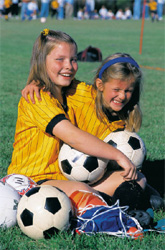 |
 |
|
Child Development |
 |
|

|
|
 Middle
Childhood (9-11 years old) Middle
Childhood (9-11 years old)
Español (Spanish)
Developmental Milestones
Your child’s growing independence from the family and interest in friends
might be obvious by now. Healthy friendships are very important to your
child’s development, but peer pressure can become strong during this time.
Children who feel good about themselves are more able to resist negative
peer pressure and make better choices for themselves. This is an important
time for children to gain a sense of responsibility along with their
growing independence. Also, physical changes of puberty might be showing by
now, especially for girls. Another big change children need to prepare for
during this time is starting middle or junior high school. |
|
During this time, your child might:
- Form stronger, more complex friendships and peer
relationships. It becomes more emotionally important to have
friends, especially of the same sex.
- Experience more peer pressure.
- Become more independent from the family.
- Become more aware of his or her body as puberty approaches.
Body image and eating problems sometimes start around this age.
For information on healthy eating and exercise for children and
teenagers, visit
http://kidshealth.org/parent/nutrition_fit/index.html.
- Face more academic challenges at school.
(Adapted with permission from
Bright Futures:
Green M, Palfrey JS, editors. Bright Futures Family Tip Sheets:
Middle childhood. Arlington (VA): National Center for Education in
Maternal and Child Health; 2001)
|
|
|
For more
information, visit the American Academy of Pediatrics Developmental
Stages website. |
Positive Parenting
You can help your child become independent, while building his or
her sense of responsibility and self-confidence at the same time.
Here are some suggestions:
- Spend time with your child. Talk with her about her friends,
her accomplishments, and what challenges she will face.
- Be involved with your child’s school. Go to school events;
meet your child’s teachers.
- Encourage your child to join school and community groups, such
as a team sport, or to take advantage of volunteer opportunities.
- Help your child develop his own sense of right and wrong. Talk
with him about risky things friends may pressure him to do, like
smoking or dangerous physical dares.
- Help your child develop a sense of responsibility—involve your
child in household tasks. Talk to your child about saving and
spending money wisely.
- Meet the families of your child’s friends.
- Talk with your child about respecting others. Encourage your
child to help people in need. Talk with him or her about what to
do when others are not kind or are disrespectful.
- Help your child set his own goals. Encourage him to think
about skills and abilities he would like to have and about how to
develop them.
- Make clear rules and stick to them. Talk to your child about
what you expect from her when no adults are supervising. If you
provide reasons for rules, it will help your child to know what to
do in those situations.
- Use discipline to guide and protect your child, instead of
punishment to make him feel badly about himself.
- Talk with your child about the normal physical and emotional
changes of puberty.
- Encourage your child to read every day. Talk with her about
her homework.
- Be affectionate and honest with your child, and do things
together as a family.
Child Safety First
More independence and less adult supervision can put children at
risk for injuries from falls and other accidents. Motor vehicle
crashes are the most common cause of death from unintentional injury
among children of this age.
- Protect your child in the car. All children younger than 12
years of age should ride in the back seat with a seat belt
properly fastened. Children should ride in a car seat or booster
seat until they are 4 feet 9 inches tall (because adult seat belts
do not fit people under this height). Visit the
National Highway Traffic Safety Administration for more
information.
- Know where your child is and whether an adult is present. Make
plans with your child for when he will call you, where you can
find him, and what time you expect him home.
- Many children get home from school before their parents get
home from work. It is important to have clear rules and plans for
your child when she is home alone. Visit
KidsHealth: When It’s Just You After School for safety tips
for your child at home when you can’t be there.
Links for Parents
CDC’s Healthy Youth! webpage has information about six kinds
of health behavior that contribute to the leading causes of death
and disability for teenagers and adults. Other important issues
affecting children and teenagers are also addressed.
KidsHealth
by the Nemours Foundation has very useful information for parents,
teens, and kids.
The National Highway Traffic Safety Administration has
information on safety recalls, and safety tips for children riding
in motor vehicles, walking, biking, playing outside, waiting at
school bus stops, and more.
Talk With Your Kids is a
national initiative by
Children Now and the
Kaiser Family Foundation to encourage parents to talk with their
children early and often about tough issues like
sex,
HIV/AIDS,
violence, and
alcohol and
drug abuse.
[Return to Top]
Date: September 20, 2005
Content source: National Center on Birth Defects and Developmental
Disabilities
|
 |
|